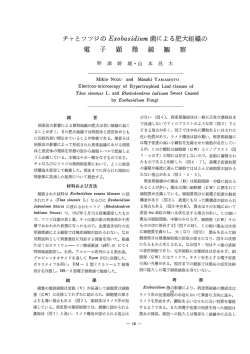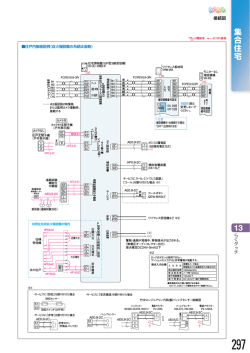
マイクロフローデバイス LC/MS をいたヒト漿中のオキシトシンの
マイクロフローデバイス LC/MS を⽤いたヒト⾎漿中のオキシトシンの⾼感度定量 ULTRASENSITIVE QUANTIFICATION ASSAY FOR OXYTOCIN IN HUMAN PLASMA USING A LC/MS MICROFLUIDICS PLATFORM 佐藤太 1、Catalin E. Doneanu2 and Paul Rainville2 1 ⽇本ウォーターズ株式会社; 2 ウォーターズコーポレーション OVERVIEW LC-SRM LC/MS を⽤いたヒト⾎漿中のオキシトシンの⾼感度定量法を開発し、 5 pg/mL の検出下限が得られた。 INTRODUCTION 医薬品の探索と開発の様々な段階において、低分⼦医薬品のバイオアナリシスをサポートする 定量的な LC-SRM 法は、様々な⽣体試料において、通常、50-100 pg/mL の定量下限を 達成している。ペプチド医薬品については、測定はより困難で、さらに低い定量下限が求められ ることが多い。 オキシトシン(OT)は、9 残基の環状ペプチドで、脳内で神経伝達物質として作⽤し、ヒト⾎ 漿中の濃度は、通常、数 pg/mL である [1]。 これまで、内在性の OT 濃度測定の⽅法としては、ELISA [2-3] 及び質量分析法が報告さ れている。しかしながら、商業的に利⽤可能な ELISA の定量下限は、内因性の濃度よりも⾼ い。近年、いくつかの質量分析計に基づく⽅法が開発されており、それらにおいては、アフィニティー による保持 [3] や、2 次元 LC/タンデム MS が採⽤されており、必要な感度を達成するために、 ⼤量注⼊(ヒト⾎漿 1.4 mL) [4] による抽出が前提になっている。 本研究では、ヒト⾎漿中の内在性 OT の検出を可能とするための、マイクロフローデバイス (1-5 µL/min の流速で使⽤する)を⽤いた⼀次元の LCSRM 法について報告する。本法 は、300 µL のヒト⾎漿試料により、内在性 OT の検出が可能な感度を要しており、迅速で堅 METHODS A Sample Preparation Oxytocin (OT, Sigma Aldrich, St. Louis, MO) was spiked in 300 µL of K2-EDTA human plasma (Bioreclamation, East Meadow, NY) at the following concentrations: 1, 2, 5, 10, 50, 100, 500, 1000, 5000, 13 15 C N-isotopically labeled OT 10000 and 100000 pg/mL. (CYIQNCPLG-NH2, Sigma Aldrich) was added as an internal standard at 10000 pg/mL in all samples and the plasma samples were diluted 1:1 with 4% H3PO4. Samples were clean-up using Oasis MCX µElution Plates (Waters P/N 186001830BA, 30 µm particles). After sample loading, the wells were washed with 200 µL of 2% formic acid (FA) in DI water and with 5% CH3OH in DI water. Three elution solvents were investigated in order to optimize the extraction protocol. First, wells were eluted with 2x50 µL of 25% ACN, 2% NH4OH; followed by elution with 2x50 µL of 50% ACN, 2% NH4OH; and finally the third elution step was performed with 2x50 µL of 75% ACN, 2% NH4OH. SPE eluates were diluted 1:1 with 0.1% FA in DI water and analyzed by LC/MS. LC/MS Conditions Samples were analyzed on a 150 µm ID x 5 cm prototype microfluidic device packed with 1.7 µm BEH C18 particles coupled to a XevoTM TQS mass spectrometer. Separations were performed at a flow rate of 3 µL/min at 60 oC, using a mobile phase containing 0.1% FA in DI water (Solvent A) and 0.1% FA in acetonitrile (Solvent B). The analyte was eluted using a “step” gradient from 0 to 20% Solvent B (in 0.2 min) following by a 4 min isocratic step at 20% B. The washing step with 90% B was started after analyte elution. SRM Assay SAMPLE PREPARATION OT and 13 C15N OT are spiked into plasma 1:1 dilution with H3PO4 2 washing steps 0 -1 +3 0 SRM analyses were performed on a XevoTM TQ-S mass spectrometer equipped with a TRIZAIC ESI source. Operating parameters were: ESI potential 3.2 kV, source temperature 100 oC, desolvation gas 0.2 bar, MS1/MS2 isolation window 0.75 Da (FWHM). Collision energy and cone voltage we optimized on the LC-timescale using a dwell time of 10 ms. SPE Optimization -2 A B C 2500000 5% CH3OH R2=0.998 2000000 100 pg/mL 1,000 pg/mL 25% ACN, 2% NH4OH 1000000 0 +1 +2 500000 10,000 pg/mL +5 C 50% ACN, 2% NH4OH 0 0 100,000 pg/mL D Figure 1. Optimization of tile positioning: left and right, along X-axis is shown in panel A; up and down, along Y-axis, is displayed in panel B and Zaxis optimization (in and out) is presented in panel C. The numbers shown on each slide correspond to the unit settings of the XYZ stage. A b6 B [M+H]+1 20000 40000 60000 80000 100000 Conc (pg/mL) 75% ACN, 2% NH4OH Figure 4. Optimization of the SPE protocol for oxytocin in human plasma: (A) washing step with 5% methanol; (B) elution with 25% ACN, 2% NH4OH; (C) elution with 50% ACN, 2% NH4OH; (D) elution with 75% ACN, 2% NH4OH. The volume of sample injected was 1 µL for each run. Figure 7. Example of the linearity of the SRM assay: MRM chromatogram for five oxytocin concentrations spiked in plasma, covering a dynamic range of four orders of magnitude (from 10 to 100,000 pg/ mL). The volume of each injection was 1 µL. C-Y-I-Q-N-C-P-L-G-NH2 Figure 9. Calibration curve for oxytocin spiked in human plasma in the range of 5 - 100,000 pg/mL. CONCLUSIONS Assay Reproducibility b6 50% ACN, 2% NH4OH elution Concentration (pg/mL) Run01 Run02 Run03 5 10 50 100 500 1000 5000 10000 100000 306 617 2614 5374 26588 56596 284592 622345 6351754 293 639 2529 5520 23519 59901 301425 597699 6573004 267 570 2578 5678 24815 55377 292805 610475 6748837 Peak Area Run04 Run05 Mean RSD % 248 575 2373 5466 24506 57642 299544 617184 6475522 278 593 2527 5466 25286 57973 296964 606467 6486703 8.1 5.5 3.7 2.7 5.8 3.7 2.9 2.5 2.8 ・ ヒト⾎漿中のオキシトシン定量のための、迅速で、堅牢であり、かつ⾮常に感度 の⾼い LC-SRM 法を開発した +2 [M+2H] Figure 2. ESI-MS spectrum of oxytocin (A) and the MS/MS spectrum (B) produced by the fragmentation of the singly charged precursor using a collision energy of 28 eV. Both spectra were recorded on the LC timescale. Peak Area 60000 Figure 5. RADAR scans indicating the presence of sample matrix in the SPE elution solvent. Full MS scans (m/z=400-1400, 200 ms scantime) were acquired along with SRMs throughout the entire LC run. 40000 CE (eV) CYIQNCPLG-NH2 1007.4->723.3 100 28 20000 CYIQNCPLG-NH2 1014.4 -> 730.3 100 28 0 25% ACN, 2% NH4OH elution 28 eV A 80000 CV (V) CE (eV) 20 40 0.1% FA blank 60 plasma blank 100 V B 150000 2 pg/mL OT in plasma LC-SRM たシグナルは、ヒト⾎漿の内在性オキシトシンに由来する可能性が考えられた ・ 測定法の直線性は、4 桁(5 - 100,000 pg/mL ヒト⾎漿にスパイク)で あった ・ 測定法の再現性は、10%以下であった Table I. Reproducibility of the oxytocin assay in human plasma across the entire concentration range (5 - 100,000 pg/mL). Five replicate injections (5 µL injection volume) were performed for each concentration. Peak area RSD % was better than 10% for all concentrations. References 1.Burd JM, Weightman DR, Baylis PH J. Immunoassay, 1985, 6, 2.Fisher LA, Fernstrom JD Life Sc., 1981, 28, 1471. A 3.Cool DR, DeBroose D, J Chromatogr. B, 2003, 792, 375. B Peak Area RSD: 5.5% 4. Zhang G, Zhang Y, Fast DM, Lin Z, Steenwyk R Anal. Biochem., 2011, 416, 45. 5. Sobhi HR, Vatansever B, Wortmann A, Grouzmann E, Rochat B C J Chromatogr. A, 2011, 1218, 8536. 6. Mabrouk OS, Kennedy RT J Neurosc. Meth., 2012, 209, 127. 100000 D 5 pg/mL OT in plasma-LLOQ 50000 CV(V) 0 0 20 40 60 80 100 120 140 Figure 3. Collision energy screening (CE, panel A) and cone voltage optimization (CV, panel B) performed on the LC time scale. Fifteen collision energy values in the range of 4-60 eV were optimized in a single LC-SRM run using a fixed cone voltage of 40 V. Nineteen CV values (5-140 V range) were then optimized using a fixed CE of 28 eV in a subsequent injection. TO DOWNLOAD A COPY OF THIS POSTER, VISIT WWW.WATERS.COM/POSTERS ・ オキシトシン定量下限は 5 pg/mL であった。ヒト⾎漿ブランク試料で検出され 227. Peak Area 200000 276 565 2539 5294 27004 60349 306453 584633 6284397 Assay LLOQ 0 Xevo TQ-S tandem quadrupole mass spectrometer equipped with a TRIZAIC source. 10 pg/mL 1500000 MRM Transition dilution with 0.1% FA 3000000 +2 -1 Peptide sequence Elution with 25% and with 50% ACN, 2% NH4OH Assay Linearity +1 LC-SRM The injection volumes were in the range of 1-5 µL and the total runtime for the SRM assay was 10 min. 牢な⽅法である。 RESULTS B +2 +1 Peak Area 10 pg/mL OT in plasma E Figure 6. Establishing the LLOQ of the assay: solvent A blank injection (0.1% FA, panel A); human plasma blank (B); 2 pg/mL oxytocin spiked in human plasma (C); 5 pg/mL oxytocin spiked in human plasma (LLOQ, panel D) and 10 pg/mL oxytocin spiked in human plasma (E). The volume of each injection was 1 µL. Figure 8. Reproducibility of the SRM assay: five replicate injections (2 µL volume) of 10 pg/mL oxytocin spiked in serum. Peak area RSD was 5.5%. ©2014 Waters Corporation MKT14080
© Copyright 2025

